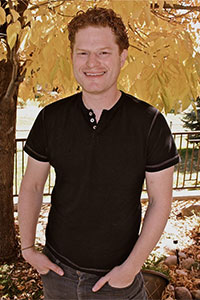Colorado physicist Randy Bartels, an expert in creating technologies that shed light on unseen worlds in biology, will join the Morgridge Institute for Research this summer as an investigator in the biomedical imaging initiative.

Bartels, a professor of electrical engineering at Colorado State University in Fort Collins, specializes in the development of light microscopy and laser technology for applications such as ultra-deep imaging of tissues and vastly improved resolution of cell populations. He also will join the biomedical engineering faculty at the University of Wisconsin–Madison.
“I’ve been working in the space of biomedical imaging for more than 15 years, but Morgridge and UW–Madison will offer an opportunity to work with a wider range of collaborators in biology,” says Bartels. “I think true innovation has to be collaborative, built on conversations across disciplines and lots of trial and error. I’m really excited to work with biologists who want to push what we’re capable of imaging.”
Two current Bartels research projects have captured the attention of the “Frontiers of Imaging” program at the Chan Zuckerberg Initiative (CZI). In 2020, Bartels received CZI support for a project to image more deeply into tissue by developing ways to suppress scattered light and increase resolution. And in 2022, Bartels partnered on a CZI project to develop a laser technology that can illuminate large populations or regions of cells, at much faster speed and higher resolution than conventional techniques.
Bartels says a foundation executive once told him they are drawn to researchers who think more like venture capitalists, willing to go after high-reward challenges despite the elevated risk of failure that goes hand in hand with such endeavors. He says that the Morgridge Institute’s embracing of “advisable risk” in research is in keeping with that philosophy.
Bartels has earned high honors for his work. He was awarded the Adolph Lomb Medal from the Optical Society of America, a National Science Foundation CAREER award, a Sloan Research Fellowship in physics, an Office of Naval Research Young Investigator Award, a Beckman Young Investigator Award, and a Presidential Early Career Award for Science and Engineering (PECASE).
A self-described “science nerd” in his youth, Bartels was a first-generation undergraduate student when he attended Oklahoma State University in the early 1990s. His curiosity about research was helped along by his exposure to an early iteration of the internet called “Gopher,” created by the University of Minnesota. Long before search engines became ubiquitous in modern life, Bartels jumped on Gopher (designed mostly for academic researchers) to explore what summer research projects might be open to undergraduates.
“I think true innovation has to be collaborative, built on conversations across disciplines and lots of trial and error.”
Randy Bartels
The search led him to a summer research opportunity at the Ames Research Lab at Iowa State University, where he worked on semiconductor thin film growth. The next year, he landed a summer research gig at the University of Michigan’s Center for Ultrafast Optical Science. There he met the scientists who would become his Ph.D. mentors.
While Bartel’s academic training is almost exclusively in physics and engineering, today he is most at home at the intersection between physical sciences and biology.
“These days, I spend a lot more time reading biology papers than I do physics papers, because I want to understand some of the problems that we really need to solve,” he says. “And also, I’m not naive enough to think that I come in with a technology, and it’s just going to solve problems on its own.”
One class of experiments Bartels plans to pursue at Morgridge is developing optical correlative imaging with cryo-EM and MRI. In the case of cryo-EM, he will exploit unique properties of his new fluorescent super resolution imaging technique. In particular, the microscopy can image large sample volumes, even when optical aberrations are present.
Working at Morgridge will also enable a class of experiments to develop correlative MRI and optical imaging, Bartels says. This line of inquiry will rely on the development of a new label-free molecular detection approach based on non-resonant transient absorption.
